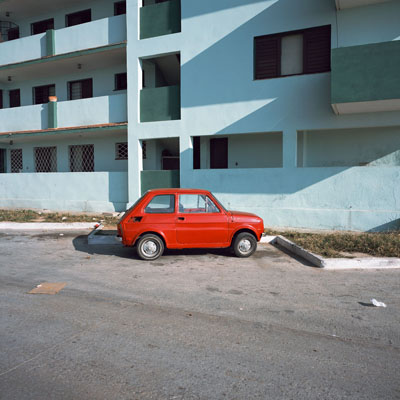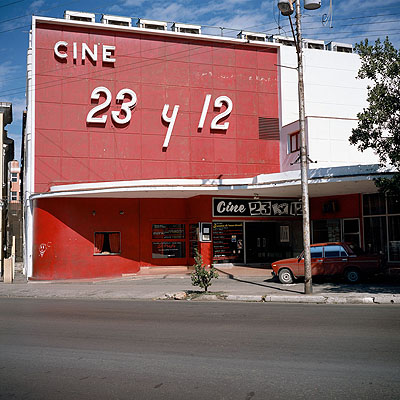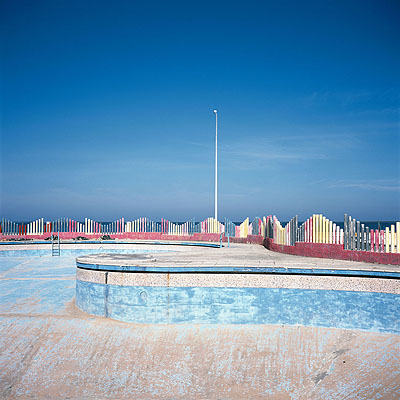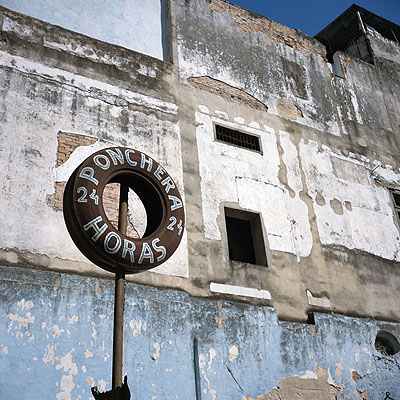
Charles Johnstone »
Havana 2006
Exhibition: 13 Nov – 22 Dec 2009
Kunsthandel Jörg Maaß
Rankestr. 24
10789 Berlin

Kunsthandel Jörg Maass
Rankestr. 24
10789 Berlin
+49 (0)30-2115461
kontakt@kunsthandel-maass.de
www.kunsthandel-maass.de
Mon-Fri 10-16 +

CHARLES JOHNSTONE - HAVANA 2006 We are pleased to announce the first European solo-exhibition of the photographer Charles Johnstone, born in 1952 in New York. Color photographs from Johnstone's Havana 2006 series, covering the years 2006-2007, will be on view. In the upcoming year, Johnstone's Havana project will be included in the group exhibition, Cuban Avant-garde Art, at the Katonah Museum of Art in New York. Johnstone is a self-taught photographer. He has acknowledged a variety of influences such as Eugène Atget, Walker Evans, William Christenberry, Stephen Shore, Robert Adams, Luigi Ghirri and Ed Ruscha. Of special interest is the importance of Edward Hopper for Johnstone's work: his sophisticated play of light, the strong, geometric flat forms, and the profound sense of alienation and loneliness. Johnstone's photographs from Havana are taken with a 6 x 6 cm camera and this square format has ultimately become his signature. Johnstone's work differentiates itself from the requisite Cuban motives: here there are no nostalgic, romanticized images of imposing, classic American cars and luminous facades of one-time magnificent Colonial-style buildings, on which the plaster is now peeling. Particularly significant in Johnstone's work is the precisely calculated composition required by the format of the square, with an emphasis on the vertical and horizontal, intersecting lines, bordering fields of shadows and color contrasts. In this way, Johnstone provokes a moment of inner calm. People, however, do not appear in his images. He is interested instead in gas stations, basketball courts, deserted cars and areas such as abandoned playgrounds or public swimming pools, which are normally full of life. It is here he records his extremely personal impression of Havana: a lonely, deserted city, whose cumulative decay makes its advance. Johnstone does not want to influence our view of Havana, rather his sober images, which are free from emotion, enable us to see and interpret the city through our own eyes. The exhibition will also include a selection of works from Johnstone's artist colleagues. A limited number of copies of his book Havana 2006 with an introduction by T.A. Nathan, will be available for 30 Euros. CHARLES JOHNSTONE - HAVANA 2006 Wir freuen uns sehr, die erste europäische Einzelausstellung des 1952 in New York geborenen Photographen CHARLES JOHNSTONE präsentieren zu können. Gezeigt werden Farbaufnahmen aus der Serie Havana 2006, entstanden in den Jahren 2006-2007. Im kommenden Jahr wird Johnstones Serie in die Ausstellung Cuban Avant-Garde Art des Katonah Museum of Art, New York, integriert. Charles Johnstone ist Autodidakt. Als Vorbilder nennt er selbst Eugène Atget, Walker Evans, William Christenberry, Stephen Shore, Robert Adams, Luigi Ghirri und Ed Ruscha. Unübersehbar ist aber auch der Einfluss Edward Hoppers: eine ausgefeilte Lichtregie, strenge geometrische Flächenformen und die Einsamkeit in dessen Bildern. Johnstones Aufnahmen von Havanna entstanden mit einer 6 x 6-Kamera und das quadratische Format ist mittlerweile zum Markenzeichen des Photographen geworden. Zwar geben die Bilder größtenteils die gewohnt farbenfrohen Ansichten der Straßen Havannas wieder, doch unterscheiden sie sich von den üblichen Kubamotiven: den typisch nostalgischen, oft romantisierenden Aufnahmen imposanter amerikanischer Oldtimer und leuchtender Fassaden ehemaliger Prachtbauten im Kolonialstil, an denen der Putz abblättert. Bei Johnstone ist vor allem die äußerst durchdachte Komposition von Bedeutung, die das quadratische Format erfordert; geleitet von Senkrechten und stark betonten Waagrechten, von Linien, die sich durchkreuzen, von begrenzenden Schattenflächen und Farbkontrasten. Damit provoziert Johnstone einen Moment des Innehaltens. Menschen sucht man in seinen Bildern dagegen vergebens. Ihn interessieren Tankstellen, Basketballplätze, Autos ohne Insassen und Orte, die einst voller Leben waren, wie verlassene Spielplätze oder Schwimmbäder. Damit hält er seinen ganz persönlichen Eindruck von Havanna fest: den einer einsamen, verlassenen Stadt, deren Verfall zunehmend voranschreitet. Johnstone möchte aber keine Geschichten erzählen - vielmehr gibt uns seine nüchterne Bildwelt, frei von Emotionen, die Möglichkeit, die Stadt mit eigenen Augen zu sehen und zu interpretieren. Die Ausstellung wird durch einige verwandte Arbeiten von Johnstones Künstlerkollegen abgerundet. Eine limitierte Auflage des Buches Havana 2006 mit einer Einführung von T. A. Nathan ist für € 30 erhältlich.

